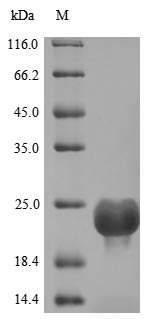Recombinant Human Dedicator of cytokinesis protein 8 (DOCK8) is produced using a yeast expression system and covers amino acids 560 to 729. This partial protein carries an N-terminal 10xHis tag that helps with purification and detection. The product shows purity levels above 85%, confirmed through SDS-PAGE analysis. This protein is meant for research use only and should not be used for diagnostic or therapeutic purposes.
The Dedicator of cytokinesis protein 8 (DOCK8) appears to be involved in cellular processes that reorganize the cytoskeleton. It likely plays a critical role in immune system function, particularly within signaling pathways that control cell migration and survival. Given its apparent importance in immune cell dynamics, DOCK8 has become a significant focus for studies examining immunodeficiencies and related immune conditions.
Potential Applications
Note: The applications listed below are based on what we know about this protein's biological functions, published research, and experience from experts in the field. However, we haven't fully tested all of these applications ourselves yet. We'd recommend running some preliminary tests first to make sure they work for your specific research goals.
The recombinant human DOCK8 fragment (560–729aa) expressed in yeast with an N-terminal 10×His tag is a partial protein fragment, not the full-length DOCK8. Yeast expression systems can often produce eukaryotic proteins with some degree of correct folding and post-translational modification, but for multi-domain, cytosolic signaling proteins like DOCK8, proper folding and bioactivity are not guaranteed—especially for isolated partial domains. The 560–729 region represents only a small portion of DOCK8, and without evidence of activity or secondary structure validation (e.g., CD or binding assays), its native conformation and functionality remain uncertain. Therefore, it can be useful for antibody generation or binding screening, but not for structural or enzymatic activity studies unless validated.
1. Protein-Protein Interaction Studies
This recombinant DOCK8 fragment (560–729aa) can be used in pull-down assays to screen for potential binding partners of this domain if it maintains proper folding. The N-terminal 10×His tag enables immobilization on nickel-affinity resins for capturing interacting proteins from lysates or libraries. However, since the fragment is expressed in yeast and covers only part of DOCK8, correct folding and native binding interfaces are not guaranteed. Validation via secondary assays (e.g., limited proteolysis, CD spectra, or known partner binding) is necessary before functional conclusions are drawn.
2. Antibody Development and Validation
The purified DOCK8 fragment is suitable for generating and validating antibodies against the 560–729aa region. Its >85% purity and His-tag facilitate immunization and downstream assays like ELISA or Western blot. If the protein is misfolded, antibodies produced will likely recognize linear epitopes rather than conformational ones—still useful for Western blotting, but not for conformational or functional assays. Thus, this protein is definitely suitable for antibody production, but the antibody’s specificity for the native form should be empirically confirmed.
Final Recommendation & Action Plan
The recombinant DOCK8 (560–729aa, yeast-expressed, 10×His-tagged, >85% purity) should be treated primarily as an immunological reagent rather than a functionally active protein. It is suitable for antibody production and preliminary binding screens, provided folding validation is performed. Structural or biochemical functional studies are not recommended without confirming native-like conformation.






